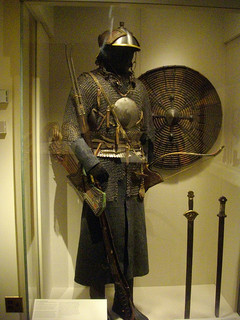Difference between revisions of "Tibet"
| (2 intermediate revisions by the same user not shown) | |||
| Line 1: | Line 1: | ||
[[File:Tibetan-armor.jpg|right|thumb|320px|A suit of 18th-19th c. Tibetan armor, shield, and weapons. [[Metropolitan Museum of Art]].]] | [[File:Tibetan-armor.jpg|right|thumb|320px|A suit of 18th-19th c. Tibetan armor, shield, and weapons. [[Metropolitan Museum of Art]].]] | ||
| − | Tibet is a center of Himalayan Buddhism, and was a powerful independent kingdom for many centuries, until its conquest by Chinese Communist forces in 1949. | + | Tibet is a center of Himalayan Buddhism, and was a powerful independent kingdom for many centuries, until its conquest by Chinese Communist forces in 1949. Never controlled by a Chinese dynasty until the 1720s, Tibet remained under [[Qing Dynasty|Qing]] control only until the end of that dynasty in [[1911]]. The following year, imperial officials and garrisons vacated the region.<ref>Ping-Ti Ho, "The Significance of the Ch'ing Period in Chinese History," ''Journal of Asian Studies'' 26:2 (1967), 190.</ref> |
| + | ==History== | ||
By the eighth century, Tibet had become one of China's most powerful neighbors; from the 760s-780s, Tibetan forces raided the [[Tang Dynasty]] capital of [[Chang'an]] every autumn. Raids grew less frequent after that, but continued into the 9th century, when the kingdom of Tibet began to decline. | By the eighth century, Tibet had become one of China's most powerful neighbors; from the 760s-780s, Tibetan forces raided the [[Tang Dynasty]] capital of [[Chang'an]] every autumn. Raids grew less frequent after that, but continued into the 9th century, when the kingdom of Tibet began to decline. | ||
| − | + | In the 1710s, a [[Dalai Lama]] was murdered. The [[Kangxi Emperor]], claiming the successor to have been chosen improperly, used this as justification to invade Tibet. Two Qing armies, under the banner of righteous retribution for the Lama's murder, entered Tibet from [[Qinghai province|Qinghai]] and [[Sichuan province]]s, meeting up together in [[Lhasa]] in [[1720]], and installing a new Dalai Lama, loyal to the Qing.<ref>Jonathan Spence, ''The Search for Modern China'', Second Edition, W.W. Norton & Co. (1999), 68.</ref> Tibet was named a Qing protectorate in [[1751]].<ref>Robert Tignor, Benjamin Elman, et al, ''Worlds Together, Worlds Apart'', vol B, Fourth Edition, W.W. Norton & Co (2014), 502.</ref> | |
{{stub}} | {{stub}} | ||
Latest revision as of 19:27, 23 February 2015

Tibet is a center of Himalayan Buddhism, and was a powerful independent kingdom for many centuries, until its conquest by Chinese Communist forces in 1949. Never controlled by a Chinese dynasty until the 1720s, Tibet remained under Qing control only until the end of that dynasty in 1911. The following year, imperial officials and garrisons vacated the region.[1]
History
By the eighth century, Tibet had become one of China's most powerful neighbors; from the 760s-780s, Tibetan forces raided the Tang Dynasty capital of Chang'an every autumn. Raids grew less frequent after that, but continued into the 9th century, when the kingdom of Tibet began to decline.
In the 1710s, a Dalai Lama was murdered. The Kangxi Emperor, claiming the successor to have been chosen improperly, used this as justification to invade Tibet. Two Qing armies, under the banner of righteous retribution for the Lama's murder, entered Tibet from Qinghai and Sichuan provinces, meeting up together in Lhasa in 1720, and installing a new Dalai Lama, loyal to the Qing.[2] Tibet was named a Qing protectorate in 1751.[3]
References
- Valerie Hansen, The Open Empire, New York: W.W. Norton & Company (2000), 227.
- ↑ Ping-Ti Ho, "The Significance of the Ch'ing Period in Chinese History," Journal of Asian Studies 26:2 (1967), 190.
- ↑ Jonathan Spence, The Search for Modern China, Second Edition, W.W. Norton & Co. (1999), 68.
- ↑ Robert Tignor, Benjamin Elman, et al, Worlds Together, Worlds Apart, vol B, Fourth Edition, W.W. Norton & Co (2014), 502.